Bramble Cay Melomys Extinction
By Paul Homewood
Climate change–ravaged? Trust the BBC to make it sound melodramatic.
It was described in 2016 as the first mammalian extinction caused by human-induced climate change.
Now the eradication of the Bramble Cay melomys has been officially recognised by Australia, its only known home.
The rodent lived solely on a tiny sand island in the Torres Strait, near the coast of Papua New Guinea (PNG). The species has not been seen since 2009.
The Australian government’s decision to list the species as extinct comes after the Queensland state government made an identical determination in 2016.
A state government report said it was almost certainly caused by "ocean inundation of the low-lying cay, very likely on multiple occasions, during the last decade, causing dramatic habitat loss and perhaps also direct mortality of individuals".
https://www.bbc.co.uk/news/world-australia-47300992
In fact, the demise of the little rat is far from as straightforward as the BBC would like you to believe.
The Conversation published a considered analysis back in 2013:
The Bramble Cay Melomys (Melomys rubicola) has one of the most unusual and precarious distributions of all Australian mammals. The melomys is restricted to an unstable 4-5 hectare coral cay in the eastern Torres Strait, off the tip of northern Australia….
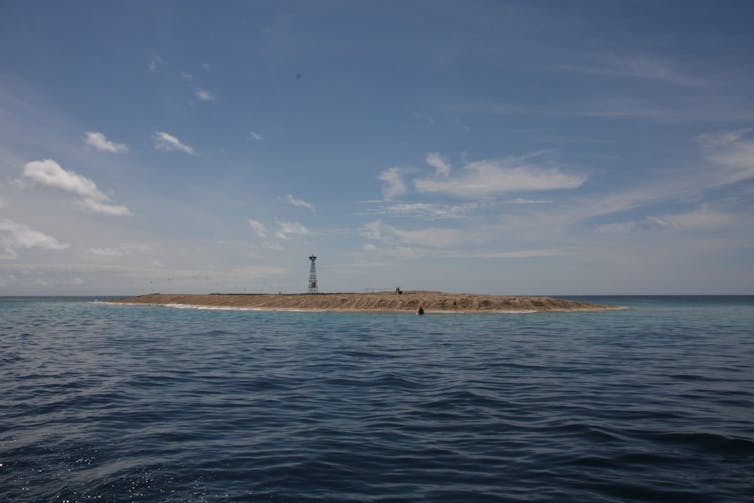
There’s really not much room on Bramble Cay, not even for a mouse.
Status
There are accounts of visits to Bramble Cay in the mid 1800s that describe the Bramble Cay Melomys as abundant.
In 1998, 42 individuals were captured in live traps over six nights. The population was estimated to be around 98 individuals.
Repeat surveys in 2002 and 2004 recorded 10 and 12 individuals respectively, and annual visits to the cay by turtle researchers since 2007 have failed to detect any presence of the species at all. The small, apparently declining population and limited distribution place the Bramble Cay Melomys at high risk of extinction.
Threats
The small population size means genetic drift, disease and introduced species all pose a threat to the species.
Habitat loss via erosion of the cay is the single most important threat, particularly given that sea levels are predicted to rise thanks to climate change. Bramble Cay is by no means stable. Between 1958 and 1987, the cay decreased in size; but in 2011 it had returned to a size comparable to 1958.
While the size of the cay varies, the vegetation on it is shrinking, and this might be the main cause of the melomys’ decline.
Bramble Cay also serves as a rookery to marine turtles and seabirds. The vegetation is disturbed by nesting seabirds throughout the year and by turtles between October and March. In our December 2011 survey the area disturbed by turtles was quite extensive, and many turtles were nesting towards the centre of the cay. Photos show a substantial reduction in the cover of vegetation between 2009 and 2011.
Bramble Cay in 2009 (left) and 2011 (right). The vegetation has noticeably shrunk, possibly thanks to the activities of turtles and seabirds. Karen Evans & Natalie Waller
https://theconversation.com/australian-endangered-species-bramble-cay-melomys-18036
Bramble Cay is only ten feet high, and consequently is naturally vulnerable to storm surges and king tides. However a rise of 3 inches since the 1970s is hardly likely to have made the slightest difference to the rat’s survival.
Furthermore, longer term records from Sydney indicate that sea level rise peaked in the 1950s, which questions how much of the rise during the 20thC was natural, rather than man-made.
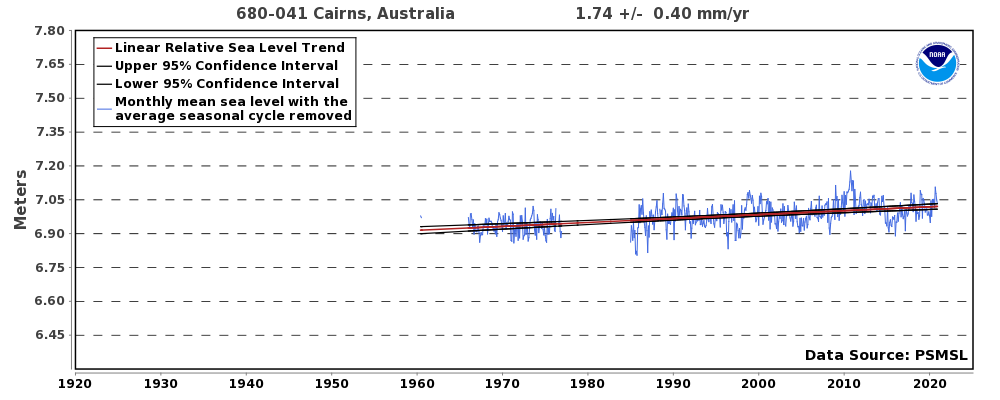
https://tidesandcurrents.noaa.gov/sltrends/sltrends_station.shtml?id=680-041
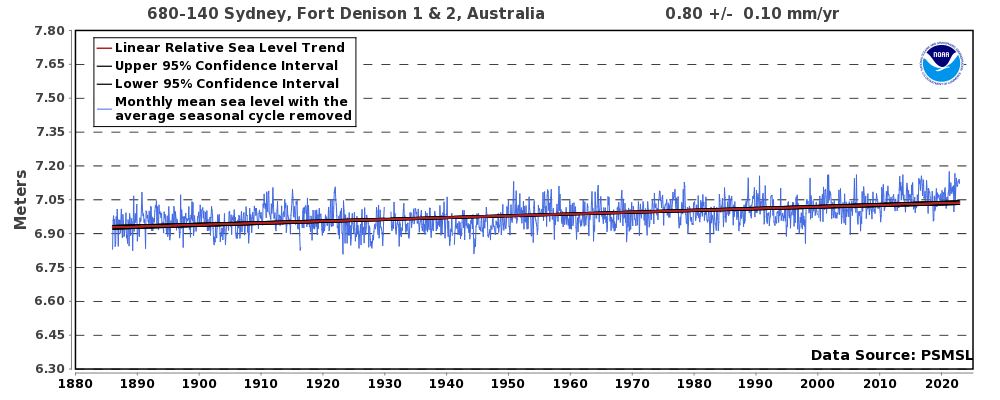
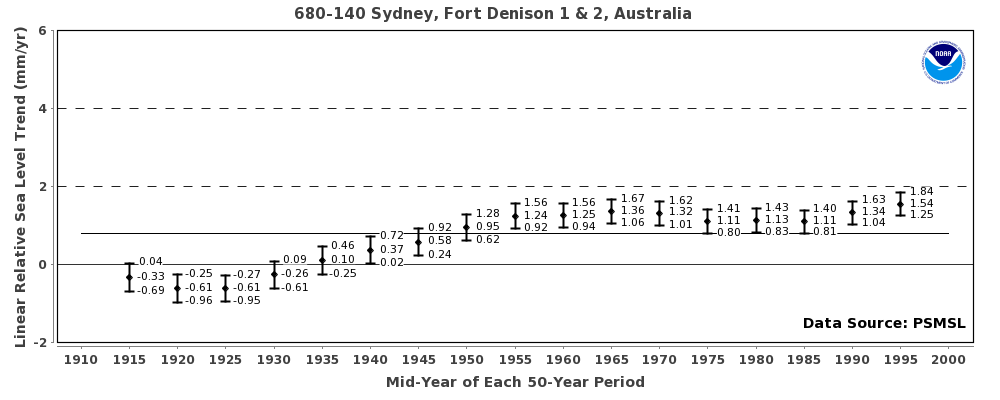
https://tidesandcurrents.noaa.gov/sltrends/sltrends_station.shtml?id=680-140
The simple fact is that such a small population in such a small and unstable habitat is always at risk of extinction for a variety of reasons.
In this instance, it seems pretty clear that the major factor was the loss of vegetation attributable to the activities of turtles and seabirds.
But that does not make very good headlines, does it?
Comments are closed.

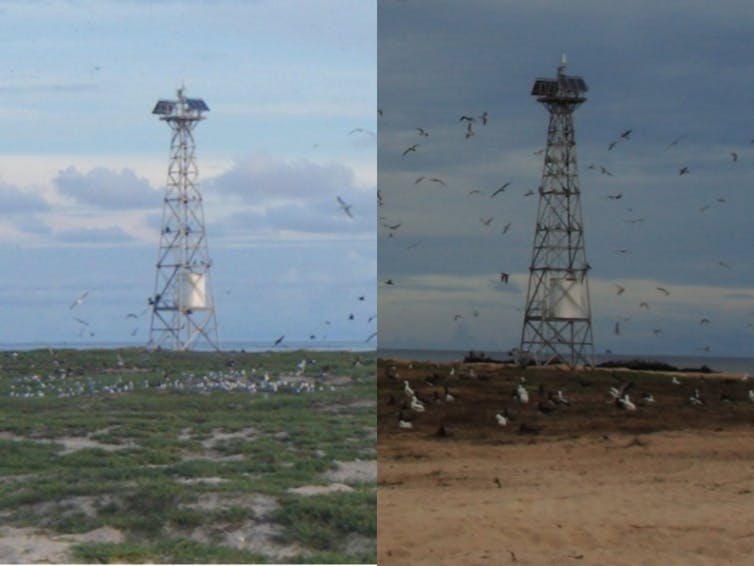
The BBC’s dire flaw of jumping to a conclusion based on prejudice, confirmation bias, is based on dishonesty as much as ignorance: that is not what the BBC are paid for, as John Reith knew.
A deliberate plan is not a flaw.
Glorious (Glorioso) Islands, Madagascar:
JAMES HORSBURGH, FRS, AS….1821:
“Glorious Islands, two in number, are low, small, situated on a reef, about 38 or 40 leagues to the W. N. W. of Cape Ambre. Capt. Moresby, in the Menai sloop of war, touched at these islands in 1821, and made the eastern one in lat. 11° 32½′ S. lon. 47° 39′ E. and the western one in lat. 11° 34¾′ S. lon. 47° 30′ E. by observations of sun and moon, nearly agreeing with chronometer. They are covered with brush wood and trees 20 or 25 feet high, and are about 15 feet above the sea level, connected by a coral bank nearly 3 miles in breadth in some places, which space is filled with small isles, sand banks and lagoons, through which no passage appears…”
Wikipedia… Glorioso Islands today:
“The climate is tropical and the terrain is low and flat, varying from sea level to 12 metres (39 ft). Île de Lys in particular is a nesting ground for migratory seabirds and turtles lay eggs on the beaches.”
About 15 feet above sea in 1821 and about 40 feet now… after 198 years. Thanks to climate change?
The Britannica cays reference makes it sounds like the height is function of accretion/erosion processes and therefore small steady sea level rise is of no significance.
It says even large cays are at risk of being completely eradicated by storms, they always have been and always will be.
Scientists like declaring new species, to boost their career, and also so that they can immediately declare them vulnerable and then extinct – in reality they are just sub populations. These inbred rats probably have close relatives from whence they arrived.
It’s 50/50 if they arrived on floating debris or a boat – so man may be the only reason they were there in the first place.
The green turtle activities are an obvious issue, as are many of the bird species listed as nesting there – several papers mentioned that the rats avoided bird nesting areas, and certainly some of the larger species, even though predominantly fish feeders, would not turn their nose up at a handy rat snack.
A google search for melomys had a pretty good echo for first mammal extinction. I did find through the Sydney Morning Herald this paper saying extinctions are running 100-1000 times above normal background level. It discusses 3 extinctions. Really scary that they can get 1000 x normal rate and only talk about 3.
https://onlinelibrary.wiley.com/doi/full/10.1111/cobi.12852
“Between 1958 and 1987, the cay decreased in size; but in 2011 it had returned to a size comparable to 1958.”
So for 30 years the sea level around the cay seems to have risen but from 1987 – 2011, it had actually shrunk again? Surely not due to man-made climate change??? Isn’t AGW supposed to work the opposite way? Is this another BBC statistic they let fall between the cracks, like that of the IPPR the other day? Or have I maybe missed something?
One big storm cold have carried them all away!
The claim this rodent is “climate-change ravaged” is surely the most absurd headline in 2019.
It’s deteriorated to the point now, where the media (and gov’t officials, etc) don’t even need some stupid alarmist study suggesting that there might – could be – a human footprint in some weather event, extinction, etc.; rather, they now seem to have little push back when they simply say it was caused by [man-made] climate change. A full-page feature story in the Los Angeles Times, a couple of days ago was headlined, “Climate fuels conflict in Nigeria — Global Warming is forcing farmers and herders into closer proximity, sparking more deadly violence.”
The evidence? The cause of the ‘climate’ change, GW, is not mentioned anywhere in the article.the term “climate change” appears once in the entire piece, in this context:
“Farmers and cattle herders have clashed over land for as long as most people can remember in Kaduna. But they’re coming into increased proximity due to climate change.
As grasslands have been degraded in northern Nigeria, semi-nomadic herders have starting moving their herds into densely populated farming areas to the south. At the same time, as Nigeria’s population has boomed, farmers have expanded their fields, often into the herders’ traditional grazing routes.”
Seems to make the case that the root cause here (for whatever it is) is population growth; certainly not GW, nor CC.
They simply made it up – and then shrilled about it in the headline.
But perhaps a 1/2 million readers read the headline, walking away thinking perhaps AOC is our only hope.
God help us.
“In 1998, 42 individuals were captured in live traps over six nights. The population was estimated to be around 98 individuals.”
‘Scientists’ tripped almost 1/2 of the entire population. What effect does that have on the poor little critters?
Please note what was actually said: “Habitat loss via erosion of the cay is the single most important THREAT, particularly given that sea levels are PREDICTED to rise thanks to climate change.”
It doesn’t say that sea levels have risen, and neither did the state government:
“A state government report said it was almost certainly caused by “ocean INUNDATION of the low-lying cay, very likely on multiple occasions, during the last decade, causing dramatic habitat loss and perhaps also direct mortality of individuals”.
Ocean inundations are not the same as sea level rise. The threat of them takes place all the time. Semantics?
They say storms/surges have increased because of climate change.
It’s patent nonsense, in such a location they were doomed from the moment they swam ashore.
Reblogged this on Climate Collections.
This was discussed at WUWT a couple of years ago: https://wattsupwiththat.com/2016/06/14/claim-global-warming-killed-a-species-of-rat/
Global warming killed my rat – LOL.
The Anthropocene: all that CO2 and the only mammal extinction is a brown rat on a desert island
http://joannenova.com.au/2019/02/the-anthropocene-all-that-co2-and-the-only-mammal-extinction-is-a-brown-rat-on-a-desert-island/
Half a degree extra in a hot country was too much for it? You can’t make this garbage up.
oldbrew:
They do make it up. This was also thrashed out on euanmeans some years ago.
The islet is 50 km. from PNG and right about where floods down the Fly river would deliver vegetation, sand/mud and any light animals.
The “scientists” have checked the DNA of rats on Australia 200km. away but apparently NEVER checked what variety and numbers were in PNG.
Funny that. They found an ‘extinct’ bee last week.
I reckon they are just hiding.
I can’t remember where I read it, but I think something like 2/3 of all animals declared extinct are subsequently rediscovered and the average time it takes is 60 years.
I think those horrible Birds & Turtles have eaten them all, especially the young ones.
Any idea what the tower is in that picture? Is it possible that it is potentially the source of an element not in the normal diet that might affect the reproductive capabilities, or that in the process of building that tower, they inadvertently left behind something that would affect a small, potentially stable, population through poisoning? I find the tower, or the construction of it, the far more likely reason that this variant of a mouse went extinct.
“Climate change-ravaged rodent listed as extinct” Is it possible for the BBC get any more emotion and any less factual and scientific information into this? The BBC article was clearly deliberately long on emotion and very short on facts. They omitted to mention several important stresses on the population especially the amount of inbreeding which had been recorded as a factor enfeebleing the population. Strange that the BBC “missed “that together with “missing” the fact that the island is only 3m above high water at it’s highest point….strange that for a media outlet which has a charter which promises so much integrity, unless……………….